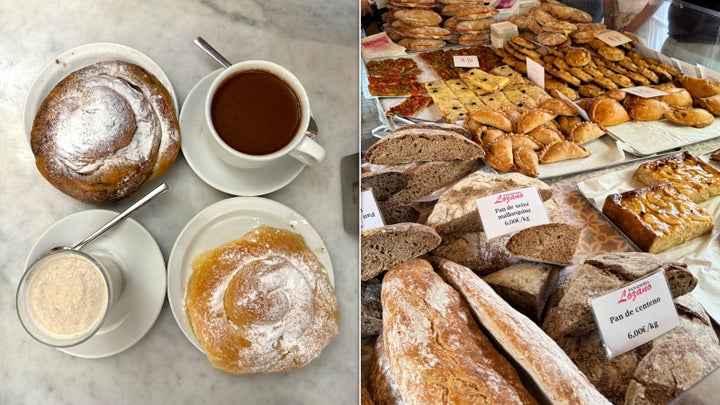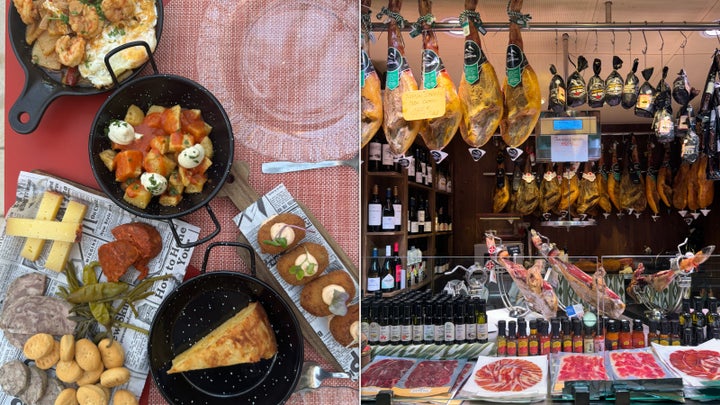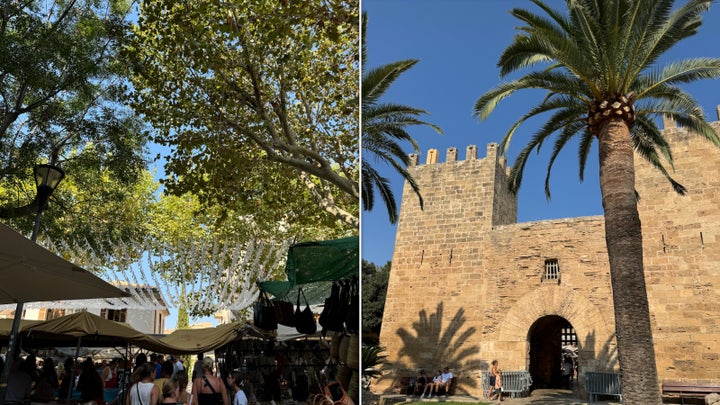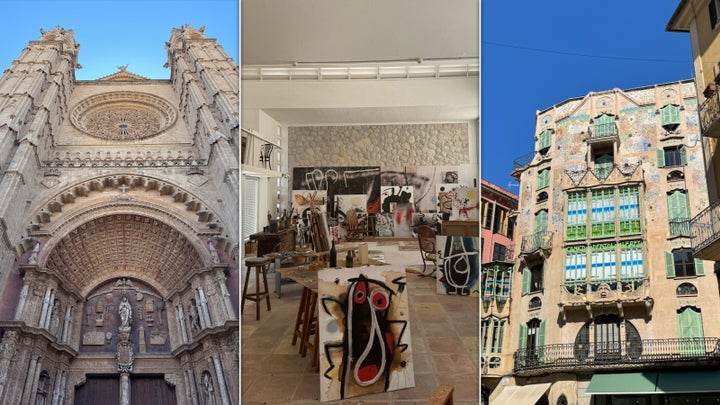Mallorca, where the two official languages are Spanish and the Mallorquin dialect of Catalan, has long been a popular vacation destination for tourists from the U.K. and Germany. The hit British reality show “Love Island” even takes place in a private villa on the Spanish island.
Although plenty of Americans have visited Mallorca, it’s not as high on U.S. travelers’ radars as other European destinations. Still, I recently visited with a friend and quickly came to understand the appeal, thanks to the beautiful beaches, delicious food, fascinating history and welcoming locals we encountered.
To help you put together an adventurous and/or relaxing vacation on Mallorca, I’ve compiled some favorite bites, attractions and other highlights from the largest Balearic island.
Where To Stay
Unfortunately, we weren’t invited to the “Love Island” villa, but my friend and I stayed at the Iberostar Selection Albufera Playa on the north coast of the island. The hotel was nicely nestled between the picturesque Playa de Muro beach and S’Albufera Natural Park, a protected wetland area filled with plant and animal life.
It is particularly important to be mindful of your accommodation choices on Mallorca, as the island has faced challenges with overtourism in recent years. Locals have been particularly vocal about the rise of vacation rentals, which has reduced the availability of housing options for longtime residents and made living there prohibitively expensive for many.
Mallorquins priced out of their homes have pleaded with tourists and opportunistic investors to stop buying up local land and transforming former residences into short-term lodging for visitors. They’ve also called for stronger government measures to limit overcrowding from cruise ship day visitors to lessen the strain on public resources.
That’s why visiting Mallorca as an overnight tourist, engaging with the local culture and economy, and staying in an established hotel is the move if you want to experience this destination.
Caroline Bologna/HuffPost
Our accommodations offered easy bus access to the town of Alcudia, where we spent an afternoon exploring, dining and shopping at the local market. We took a longer, full-day trip to Palma as well and found navigating the public transit there to be similarly straightforward.
When we weren’t exploring the island, there was plenty of opportunity to relax, particularly because this Iberostar is an all-inclusive resort. We took full advantage of the beach access and opportunities for long walks through the sand and lounged by the many pools on site (shout-out to the adults-only rooftop area).
The hotel is hardly new but has recently undergone major renovations, and we appreciated the emphasis on sustainability and reminders of the protected wetlands nearby.
For those looking to stay in other areas of Mallorca, I’ve also heard great things about La Residencia, Hotel Antigua Palma, Es Raco D’Arta, Finca Serena and Hotel Valldemossa. Traveling during the shoulder seasons of spring or fall can allow visitors to take advantage of good rates while also helping to ease concerns around overtourism.
What To Eat
As someone with a serious sweet tooth, I was pleased to learn that Mallorca is famous for a delicious pastry known as an ensaïmada. This treat comes in a spiral shape and is made with flour, eggs, sugar, water and a sort of rendered pork fat called saïm.
We sampled one classic and one chocolate ensaïmada at Ca’n Joan de s’Aigo ― a Palma cafe that dates back three centuries. The hot chocolate was also delightful (and great for dipping the pastry).

Caroline Bologna/HuffPost
Another favorite bakery in the area was Forn Fondo, which served ensaïmadas as well as other traditional Mallorquin pastries like gató d’ametlla ― a popular almond cake ― and cuarto embatumat, which is a black and white dessert from Palma.
Rounding out the sweet indulgences, we tried some classic Spanish turrón, a sort of nougat treat made with eggs, honey, sugar and almonds, plus some tiny doughnut-esque snacks called bunyols.
On the more savory side of things, we enjoyed plenty of Spanish cured meats like chorizo, jamón ibérico and the more local sobrassada. While these were tasty on their own, they also went well in bocadillos and the island’s famous llonguet rolls.
Vegetarians might like to try tombet, a traditional offering made with layers of sliced potatoes, eggplant and peppers topped with a tomato sauce. There’s a nice flatbread tart with veggies called a coca mallorquina, too.
As the name suggests, pa amb oli ― which translates to “bread with oil” ― is a straightforward dish, though it can be jazzed up with the right accouterments, and in any state, it’s a great way to savor that world-renowned Spanish olive oil. And we had ample paella, but there’s also a more traditional rice dish in the area called arròs brut, which has more of a soupy consistency.

Caroline Bologna/HuffPost
Mallorca is full of amazing restaurants and cafes where you can try traditional dishes, as well as inventive takes on the classics. Highly recommended options include La Rosa Vermuteria, Maca de Castro, La Romaguera, Mercat De Santa Catalina, Marc Fosh, La Vieja, Fornet de le Soca, and La Bodeguilla.
Additionally, we took advantage of the delicious buffets at our hotel, which featured a wide range of local ingredients and dishes from Spain and beyond. Some other favorites included the beachside eatery with fresh grilled meat and seafood and the traditional Spanish tapas restaurant on site.
What To Do
For a relatively small island, Mallorca boasts an impressive range of things to do. While some travel there to party, you can easily avoid the clubs and fill your itinerary with outdoor adventures like cycling, stargazing, hiking, birdwatching and water sports. Less daring types may enjoy the many markets, museums, gardens, churches, historic homes and immersive local experiences with food and wine.
Mallorca’s shorelines are noted for their stunning beaches, some of which feature cliffs and rocky coves, while others are covered in fine white sand. We spent hours strolling along the Playa de Muro and Playa de Alcudia and saw lots of people kayaking, sailing, snorkeling and more.
Travelers rave about Es Trenc, a vast undeveloped beach where visitors can explore salt flats, and the Cuevas del Drach, a breathtaking system of caves.

Caroline Bologna/HuffPost
Thanks to its mountainous topography, Mallorca also has incredible hiking opportunities. The Serra de Tramuntana mountain range is the most iconic on the island and has even earned UNESCO World Heritage Site status.
It’s home to the region’s longest trail, the 88-mile Dry Stone Route, but there are plenty of less intense options for those seeking a more low-key hike. Birdwatching and cycling are other popular activities in the area.
Staying on the north side of the island, we weren’t far from the Mirador Es Colomer Formentor, a famous lookout point with epic panoramic views.
As previously mentioned, we also visited Alcudia, where we enjoyed exploring the well-preserved old town and shopping at the Tuesday market. Other highlights include the ruins of the ancient Roman city of Pollentia and the eclectic Sa Bassa Blanca Museum.
The historic and picturesque town of Valldemossa is another popular destination on Mallorca. Sóller, Deià and Santanyí get a lot of love as well.

Caroline Bologna/HuffPost
Then, of course, there is the capital city of Palma. On our day there, we made sure to hit up the towering Catedral-Basílica de Santa María and the Fundació Pilar i Joan Miró studio museum. It was easy to pass the time browsing through endless ceramics, leather goods and other souvenirs at charming shops around the city. But the best part was probably just strolling the medieval streets and taking it all in.
We were pleased with the ease of taking public transit around Palma and Mallorca as a whole, particularly as the island has been plagued by serious traffic issues worsened by rising numbers of rental cars for tourists. To address the gridlock, there are plans to limit the number of cars on the roads in the future.
Back at the Iberostar, we took in the marvelous views from the rooftop lounges and appreciated many of the live performances and cultural activities (especially the cocktail-making lessons) available each day. The traditional folk music and dancing were especially memorable.







